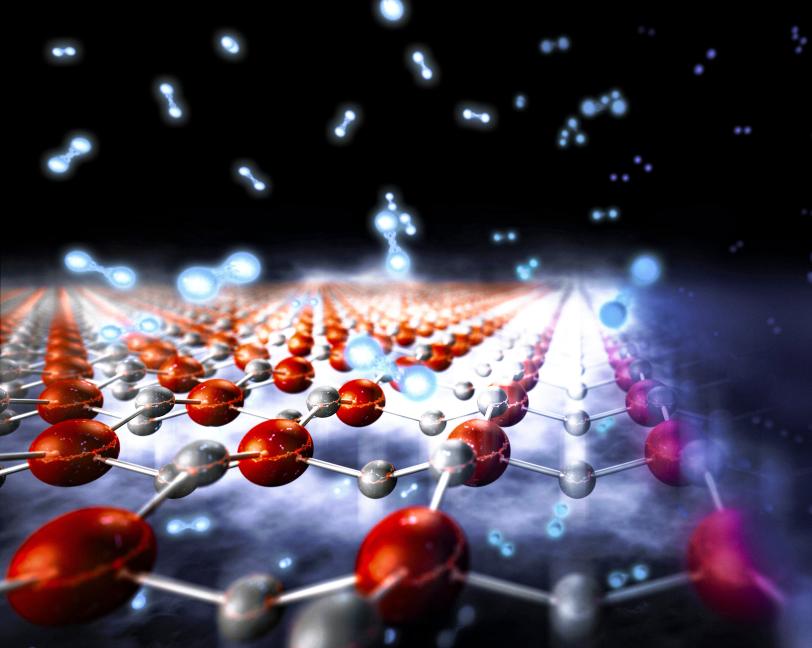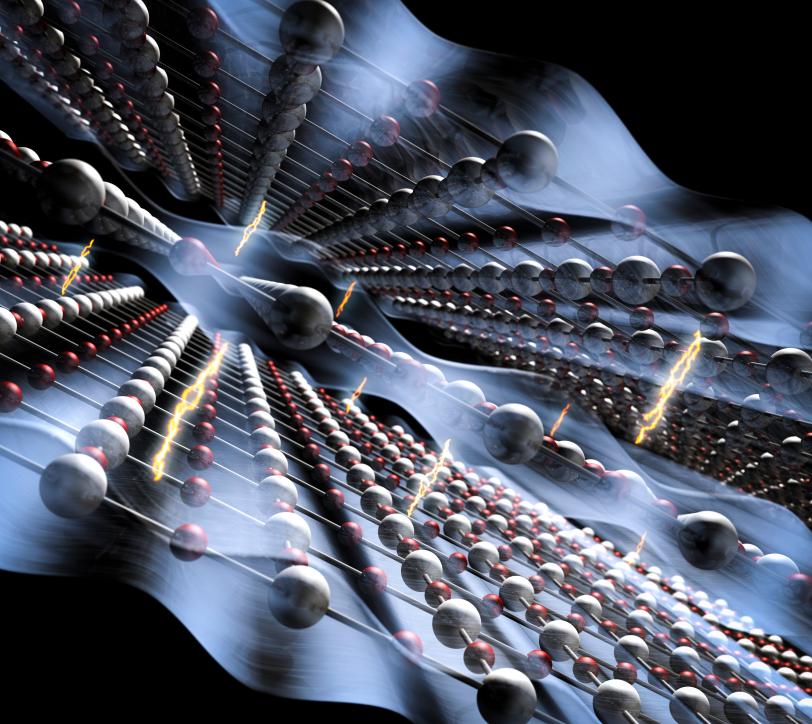Scientists make first detailed measurements of key factors related to high-temperature superconductivity
Two studies led by SLAC and Stanford capture electron 'sound waves' and identify a positive feedback loop that may boost superconducting temperatures.
By Glennda Chui
In superconducting materials, electrons pair up and condense into a quantum state that carries electrical current with no loss. This usually happens at very low temperatures. Scientists have mounted an all-out effort to develop new types of superconductors that work at close to room temperature, which would save huge amounts of energy and open a new route for designing quantum electronics. To get there, they need to figure out what triggers this high-temperature form of superconductivity and how to make it happen on demand.
Now, in independent studies reported in Science and Nature, scientists from the Department of Energy’s SLAC National Accelerator Laboratory and Stanford University report two important advances: They measured collective vibrations of electrons for the first time and showed how collective interactions of the electrons with other factors appear to boost superconductivity.
Carried out with different copper-based materials and with different cutting-edge techniques, the experiments lay out new approaches for investigating how unconventional superconductors operate.
“Basically, what we’re trying to do is understand what makes a good superconductor,” said co-author Thomas Devereaux, a professor at SLAC and Stanford and director of SIMES, the Stanford Institute for Materials and Energy Sciences, whose investigators led both studies.
"What are the ingredients that could give rise to superconductivity at temperatures well above what they are today?” he said. “These and other recent studies indicate that the atomic lattice plays an important role, giving us hope that we are gaining ground in answering that question.”
The high-temperature puzzle
Conventional superconductors were discovered in 1911, and scientists know how they work: Free-floating electrons are attracted to a material’s lattice of atoms, which has a positive charge, in a way that lets them pair up and flow as electric current with 100 percent efficiency. Today, superconducting technology is used in MRI machines, maglev trains and particle accelerators.
But these superconductors work only when chilled to temperatures as cold as outer space. So when scientists discovered in 1986 that a family of copper-based materials known as cuprates can superconduct at much higher, although still quite chilly, temperatures, they were elated.
The operating temperature of cuprates has been inching up ever since – the current record is about 120 degrees Celsius below the freezing point of water – as scientists explore a number of factors that could either boost or interfere with their superconductivity. But there’s still no consensus about how the cuprates function.
"The key question is how can we make all these electrons, which very much behave as individuals and do not want to cooperate with others, condense into a collective state where all the parties participate and give rise to this remarkable collective behavior?” said Zhi-Xun Shen, a SLAC/Stanford professor and SIMES investigator who participated in both studies.
Behind-the-scenes boost
One of the new studies, at SLAC’s Stanford Synchrotron Radiation Lightsource (SSRL), took a systematic look at how “doping” – adding a chemical that changes the density of electrons in a material – affects the superconductivity and other properties of a cuprate called Bi2212.
Collaborating researchers at the National Institute of Advanced Industrial Science and Technology (AIST) in Japan prepared samples of the material with slightly different levels of doping. Then a team led by SIMES researcher Yu He and SSRL staff scientist Makoto Hashimoto examined the samples at SSRL with angle-resolved photoemission spectroscopy, or ARPES. It uses a powerful beam of X-ray light to kick individual electrons out of a sample material so their momentum and energy can be measured. This reveals what the electrons in the material are doing.
In this case, as the level of doping increased, the maximum superconducting temperature of the material peaked and fell off again, He said.
The team focused in on samples with particularly robust superconducting properties. They discovered that three interwoven effects – interactions of electrons with each other, with lattice vibrations and with superconductivity itself – reinforce each other in a positive feedback loop when conditions are right, boosting superconductivity and raising the superconducting temperature of the material.

Small changes in doping produced big changes in superconductivity and in the electrons’ interaction with lattice vibrations, Devereaux said. The next step is to figure out why this particular level of doping is so important.
“One popular theory has been that rather than the atomic lattice being the source of the electron pairing, as in conventional superconductors, the electrons in high-temperature superconductors form some kind of conspiracy by themselves. This is called electronic correlation,” Yu He said. “For instance, if you had a room full of electrons, they would spread out. But if some of them demand more individual space, others will have to squeeze closer to accommodate them.”
In this study, He said, “What we find is that the lattice has a behind-the-scenes role after all, and we may have overlooked an important ingredient for high-temperature superconductivity for the past three decades,” a conclusion that ties into the results of earlier research by the SIMES group.
Electron ‘Sound Waves’
The other study, performed at the European Synchrotron Radiation Facility (ESRF) in France, used a technique called resonant inelastic X-ray scattering, or RIXS, to observe the collective behavior of electrons in layered cuprates known as LCCO and NCCO.
RIXS excites electrons deep inside atoms with X-rays, and then measures the light they give off as they settle back down into their original spots.
In the past, most studies have focused only on the behavior of electrons within a single layer of cuprate material, where electrons are known to be much more mobile than they are between layers, said SIMES staff scientist Wei-Sheng Lee. He led the study with Matthias Hepting, who is now at the Max Planck Institute for Solid State Research in Germany.
But in this case, the team wanted to test an idea raised by theorists – that the energy generated by electrons in one layer repelling electrons in the next one plays a critical role in forming the superconducting state.

When excited by light, this repulsion energy leads electrons to form a distinctive sound wave known as an acoustic plasmon, which theorists predict could account for as much as 20 percent of the increase in superconducting temperature seen in cuprates.
With the latest in RIXS technology, the SIMES team was able to observe and measure those acoustic plasmons.
“Here we see for the first time how acoustic plasmons propagate through the whole lattice,” Lee said. “While this doesn’t settle the question of where the energy needed to form the superconducting state comes from, it does tell us that the layered structure itself affects how the electrons behave in a very profound way.”
This observation sets the stage for future studies that manipulate the sound waves with light, for instance, in a way that enhances superconductivity, Lee said. The results are also relevant for developing future plasmonic technology, he said, with a range of applications from sensors to photonic and electronic devices for communications.
SSRL is a DOE Office of Science user facility, and SIMES is a joint institute of SLAC and Stanford.
In addition to researchers from SLAC, Stanford and AIST, the study carried out at SSRL involved scientists from University of Tokyo; University of California, Berkeley; and Lorentz Institute for Theoretical Physics in the Netherlands.
The study conducted at ESRF also involved researchers from SSRL; Polytechnic University of Milan in Italy; ESRF; Binghamton University in New York; and the University of Maryland.
Both studies were funded by the DOE Office of Science.
Citations:
Y. He et al., Science, 5 October 2018 (10.1126/science.aar3394)
M. Hepting et al., Nature, 31 October 2018 (10.1038/s41586-018-0648-3)
For questions or comments, contact the SLAC Office of Communications at communications@slac.stanford.edu.
About SLAC
SLAC National Accelerator Laboratory explores how the universe works at the biggest, smallest and fastest scales and invents powerful tools used by researchers around the globe. As world leaders in ultrafast science and bold explorers of the physics of the universe, we forge new ground in understanding our origins and building a healthier and more sustainable future. Our discovery and innovation help develop new materials and chemical processes and open unprecedented views of the cosmos and life’s most delicate machinery. Building on more than 60 years of visionary research, we help shape the future by advancing areas such as quantum technology, scientific computing and the development of next-generation accelerators.
SLAC is operated by Stanford University for the U.S. Department of Energy’s Office of Science. The Office of Science is the single largest supporter of basic research in the physical sciences in the United States and is working to address some of the most pressing challenges of our time.





